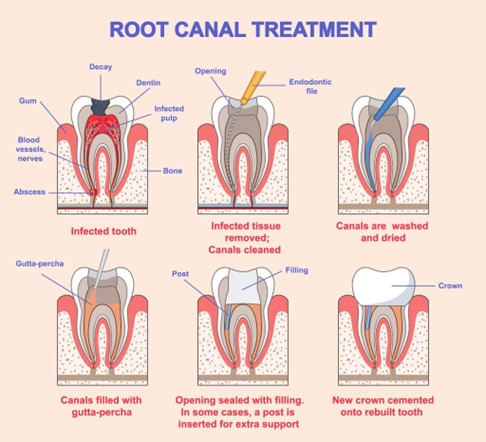Free Phone Consultation:
0118 987 2755
Beech Lane Dental Care Address:
35 Beech Lane, Earley, Reading RG6 5PT


The general process behind root canal treatment is relatively easy to understand; the dentist cleans out infected or inflamed pulp in a patient’s tooth, and fills the canals. A temporary crown is usually required afterwards.
A range of circumstances can lead to the pulp in someone’s tooth becoming inflamed or infected, thereby necessitating a root canal treatment procedure. These can include deep decay of the tooth, trauma, and/or severe gum disease.
There are various signs and symptoms that might indicate a root canal treatment is necessary. These can include toothache, sensitivity to hot or cold temperatures, and/or pain when biting or chewing. A patient may also need to consider undergoing root canal treatment if they experience a swelling of the gums around the tooth, and/or a pimple on the gum near the tooth.
So, now that you know the basics of what root canal treatment is, and in what circumstances it may be needed, let’s guide you through the actual root canal treatment procedure, step by step.

It is important to know the whole procedure of a root canal treatment, so that you can confidently discuss this topic with your dentist. The clearer you are about what the treatment involves, the better you can prepare yourself to undergo the procedure.
Typically, you will begin your journey to receiving this treatment by arranging an initial consultation with your chosen dental practice – perhaps because you have been experiencing symptoms like those mentioned above.
During this consultation, you can expect the dentist to examine your teeth and to take X-rays, so that the extent of any infection or damage can be assessed. If your dentist concludes that you will need to undergo root canal treatment, they will discuss the procedure with you. This will be an important opportunity to ask any questions and to bring up any concerns you may have.
Presuming you decide to go ahead with the root canal treatment, your dental practice will schedule your appointment. On the day of the procedure, the clinic will administer local anaesthesia to numb the affected tooth and the surrounding area. This means you should not experience any pain as the procedure is carried out.
The placement of a rubber dam around the tooth that is to be treated, will help preserve a sterile environment and prevent any spreading of the infection. This “dam” is effectively a thin latex sheet. However, for all its apparent simplicity, it is also very effective at keeping the tooth dry and guarding against contamination.
With the tooth now isolated, the dentist carrying out the root canal treatment procedure will drill through the tooth from the top (crown), to reach the root canal and the pulp chamber. Specialised instruments will be used to ensure a precise result, which will be crucial for ensuring only minimal damage is caused to the surrounding healthy tooth structure.
The dentist uses delicate files at this stage to carefully remove the damaged or infected pulp from the tooth. The canal is also cleaned and disinfected, using an antibacterial and antiseptic solution. This process is imperative when it comes to removing any remaining debris, bacteria, and infected tissue.
Placing a filling in the root canal is a major aspect of a root canal treatment. So, the dentist will need to use miniscule instruments to shape the canal, thereby ensuring it is ready to receive the filling material. Once this shaping work is done, the canal will be cleaned again.
A biocompatible material, known as gutta-percha, is used to fill the cleaned and shaped root canal. This rubber-like substance is heated and compressed into the canal, so that it fits snugly against the walls. This effectively seals the canal, guarding against the risk of any further infection developing.
The dentist will then add adhesive cement to further seal the canal – a thorough process that produces a strong seal, ensuring bacteria cannot get inside.
Once the root canal treatment procedure is done, a crown is often recommended to help ensure the tooth’s long-term stability and function. This takes the form of a custom-made cap fitted over the tooth, giving it much-needed strength and protection.
If you do indeed have a crown created following your root canal treatment, your dentist will create impressions of your tooth. This will ensure the crown matches the appearance and function of your natural tooth.
So, there you have it. From the administering of the anaesthetic and the placement of the rubber or vinyl dental dam, right through to the skilled and careful drilling of the infected tooth, the removal of the pulp, the application of the filling, and the fitting of the crown, there are various important stages of root canal treatment to know about.
Ultimately, root canal treatment is a proven, safe, and effective procedure that can save a tooth! So, if you have any concerns about your oral health or are experiencing any signs or symptoms of a tooth infection, please do not hesitate to consult a reputable dentist about this.
Remember that the early diagnosis and treatment of oral health concerns can, in many cases, help prevent the need for a root canal treatment procedure. If you are seeking a specialist to help with root canal treatment, simply contact Beech Lane Dental Care in Earley, Reading today for advice and guidance.





